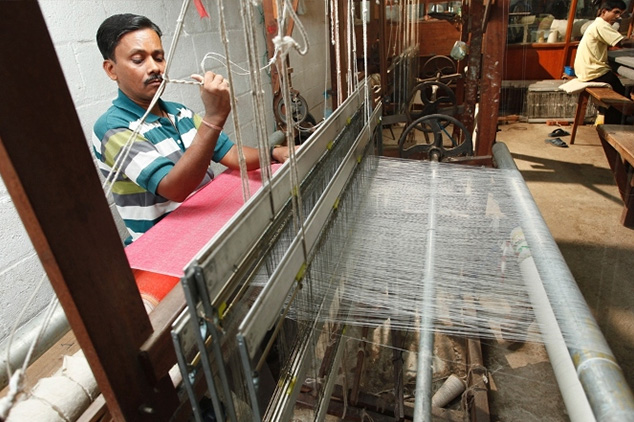Shopping Cart
Close
The Process
At Umrao Cashmere, the entire product line is either hand-woven or hand knitted. The hand weaving process, an old art form, is still practiced today at our factory with the help of some modern tools. The complicated and intricate hand weaving / finishing process goes through various stages, to become the luxurious product you receive.
Below, we have tried to give you an idea of most the different stages of production with the help of some visuals. We do hope that you will appreciate the hand work that goes into making each piece an heirloom.
RE-CONE PROCESS
At this initial stage the yarn is re-coned from a larger cone to a smaller one to be used to create the warp or is converted from cone to hank to be sent to the dye department if required.
WARPING
The warp is the set of lengthwise threads attached to a loom before weaving begins and through which the weft is woven. Based on the texture and density of the fabric required, the number of threads is decided per square inch and the cones of yarn are setup on racks to be rolled up over a drum for the required length of yarn. The width of the warp is setup based on the output of the fabric required with a margin set aside for the shrinkage during the manufacturing process.
WARP BEAM CREATION
After the creating of the warp on the drum, the warp is transferred onto beams that will go on to the loom for weaving after the drafting is complete in the next stage.
HEDDLE DRAFTING PROCESS
A heddle is an integral part of a loom. Each thread in the warp passes through a heddle, which is used to separate the warp threads for the passage of the weft. The heddles are fitted on frames that ate suspended on the loom.
Each heddle has an eye in the center where the warp is threaded through. As there is one heddle for each thread of the warp, there can be nearly a thousand heddles for fine or wide warps.
A handwoven throw will generally have between 900 to2000 warp threads and a blanket will have 1700 to 3400 warp threads and thus use that many heddles, sometimes 2 -3 warp threads are passed through one heddle depending on the yarn and texture of the fabric.
The warp is threaded through heddles on different frames in order to obtain different weave structures.
This process of setting up the warp threads through the heddles is known as drafting. It is during the drafting process that the weave pattern is setup.
LOOM SETUP
After the beam has been setup, it is now ready to be installed on the loom. During this stage the weaver takes over and ties the warp to the take-up beam and adjusts the loom’s different components to get the correct fabric and makes a small sample of the weave.
WEAVING
Weaving is a textile craft in which two distinct sets of yarns or threads are interlaced to form a fabric or cloth. The threads which run length ways are called the warp and the threads which run across from side to side are the weft.
Cloth is usually woven on a loom, while weft threads are woven through them. Weft is an old English word meaning "that which is woven".A fabric band is one which meets this definition of cloth (warp threads with a weft thread winding between).
The way the warp and weft threads interlace with each other is called the weave
CHECKING (PRE- DYE)
After the fabric comes off the loom, it is sent to the checking and finishing department to darn the yarn threads that snapped during the weaving process. Darning normally takes around 3-4 hours but in the case of complicated weaves, designs and larger pieces; it may take up to two days.
DYEING
Before the piece is set for the dyeing process, it is scoured. Scouring gets rid of any residue of the spinning oilsand foreign matter and also acts as a prewash. Dyeing is done in open vats and only one piece is dyed at a time to ensure that the exact colour is achieved. The colour fixation is done inside the vat after which the piece is hung out to air dry for 12 to 24 hours.
AFTER- DYE CHECK
The pieces are then put through another checking process to cut away any extra yarn and repair any damage that was caused in the dye process, including yarn pulls.
TASSEL MAKING
Tassels, which complete and furnish fabrics, are done manually by women as it calls for deft and nimble control and movement of the hands and patience. It takesup to almost an entire day to make the tassels on one throw and two days for a blanket. Each tassel is hand rolled and a temporary knot is put at its end. Tassels may have different styles based on the requirement and order.
SEMI FINAL IRON
Heavy dry irons and a wet muslin cloth, each throw and blanket is pressed manually. During this process the fibers are pressed down without applying direct heat
PICKING
Any dead or coarse fibre that is visible is picked out using forceps. Considering the highquality yarns that is used, this process hardly takes a few minutes, as the presence of coarse and dead fibre is limited. But on rare occasions we do find a few that were missed out during the cleaning and carding process before the yarn was spun by the spinner.
SIDE TRIM
Any extra fibre that is sticking out over the edges is trimmed to give the throws and blankets a much cleaner and tidier finish. This finishing takes the craftsman up to an hour to complete each side.
TRIM APPLICATION
If any piece needs to be trimmed with a cashmere trim or silk/ satin trim or suede / leather, then this part is taken over by an experienced master as trims call refinement and delicacy of touch to achieve the finesse. After trimming, the piece is send back to the checking department for the final inspection.
FINAL IRON
At this stage the piecesare ironed out again for the final time. While ironing butter paper is used to prevent the heat of the iron from burning the product.
LABELLING AND PACKAGING
Labeling and packaging is done after the final iron and the piece is now ready to be shipped out.









































